Tp-link WA801ND User Manual [ru]
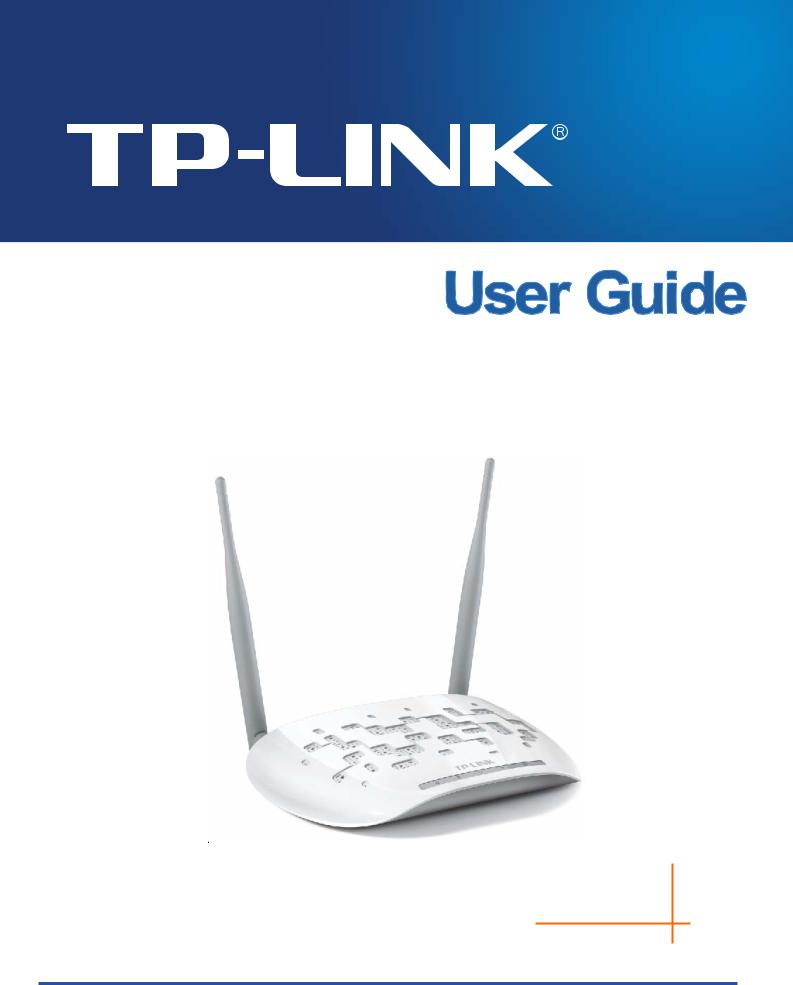
TL-WA801ND
300Mbps Wireless N Access Point
Rev: 2.0.0 1910010673
COPYRIGHT & TRADEMARKS
Specifications are subject to change without notice.  is a registered trademark of TP-LINK TECHNOLOGIES CO., LTD. Other brands and product names are trademarks or registered trademarks of their respective holders.
is a registered trademark of TP-LINK TECHNOLOGIES CO., LTD. Other brands and product names are trademarks or registered trademarks of their respective holders.
No part of the specifications may be reproduced in any form or by any means or used to make any derivative such as translation, transformation, or adaptation without permission from TP-LINK TECHNOLOGIES CO., LTD. Copyright © 2012 TP-LINK TECHNOLOGIES CO., LTD.
All rights reserved.
http://www.tp-link.com

FCC STATEMENT
This equipment has been tested and found to comply with the limits for a Class B digital device, pursuant to part 15 of the FCC Rules. These limits are designed to provide reasonable protection against harmful interference in a residential installation. This equipment generates, uses and can radiate radio frequency energy and, if not installed and used in accordance with the instructions, may cause harmful interference to radio communications. However, there is no guarantee that interference will not occur in a particular installation. If this equipment does cause harmful interference to radio or television reception, which can be determined by turning the equipment off and on, the user is encouraged to try to correct the interference by one or more of the following measures:
•Reorient or relocate the receiving antenna.
•Increase the separation between the equipment and receiver.
•Connect the equipment into an outlet on a circuit different from that to which the receiver is connected.
•Consult the dealer or an experienced radio/ TV technician for help.
This device complies with part 15 of the FCC Rules. Operation is subject to the following two conditions:
1)This device may not cause harmful interference.
2)This device must accept any interference received, including interference that may cause undesired operation.
Any changes or modifications not expressly approved by the party responsible for compliance could void the user’s authority to operate the equipment.
Note: The manufacturer is not responsible for any radio or tv interference caused by unauthorized modifications to this equipment. Such modifications could void the user’s authority to operate the equipment.
FCC RF Radiation Exposure Statement
This equipment complies with FCC RF radiation exposure limits set forth for an uncontrolled environment. This device and its antenna must not be co-located or operating in conjunction with any other antenna or transmitter.
“To comply with FCC RF exposure compliance requirements, this grant is applicable to only Mobile Configurations. The antennas used for this transmitter must be installed to provide a separation distance of at least 20 cm from all persons and must not be co-located or operating in conjunction with any other antenna or transmitter.”
CE Mark Warning
This is a class B product. In a domestic environment, this product may cause radio interference, in which case the user may be required to take adequate measures.

National restrictions
This device is intended for home and office use in all EU countries (and other countries following the EU directive 1999/5/EC) without any limitation except for the countries mentioned below:
Country |
Restriction |
Reason/remark |
|
|
|
|
|
Bulgaria |
None |
General authorization required for outdoor use and |
|
public service |
|||
|
|
Outdoor use limited to 10 France mW e.i.r.p. within the band
2454-2483.5 MHz
Military Radiolocation use. Refarming of the 2.4 GHz band has been ongoing in recent years to allow current relaxed regulation. Full implementation planned 2012
Italy |
None |
If used outside of own premises, general authorization is |
|
required |
|||
|
|
||
|
|
|
|
Luxembourg |
None |
General authorization required for network and service |
|
supply(not for spectrum) |
|||
|
|
||
|
|
|
|
Norway |
Implemented |
This subsection does not apply for the geographical area |
|
within a radius of 20 km from the centre of Ny-Ålesund |
|||
|
|
||
|
|
|
|
Russian Federation |
None |
Only for indoor applications |
Note: Please don’t use the product outdoors in France.
Industry Canada Statement:
This device complies with RSS-210 of the Industry Canada Rules. Operation is subject to the following two conditions:
(1)This device may not cause harmful interference, and
(2)This device must accept any interference received, including interference that may cause undesired operation.
IMPORTANT NOTE:
Radiation Exposure Statement:
This equipment complies with Canada radiation exposure limits set forth for an uncontrolled environment. This equipment should be installed and operated with minimum distance 20cm between the radiator & your body.
Ce dispositif est conforme à la norme CNR-210 d’Industrie Canada applicable aux appareils radio exempts de licence. Son fonctionnement est sujet aux deux conditions suivantes:
(1)Le dispositif ne doit pas produire de brouillage préjudiciable, et
(2)Ce dispositif doit accepter tout brouillage reçu,y compris un brouillage susceptible de provoquer un fonctionnement indésirable.
NOTE IMPORTANTE:
Déclaration d’exposition aux radiations:
Cet équipement est conforme aux limites d’exposition aux rayonnements IC établies pour un environnement non contrôlé. Cet équipement doit être installé et utilisé avec un minimum de 20 cm de distance entre la source de rayonnement et votre corps.

Korea Warning Statements:
.
NCC Notice:
率或變更原設計之特性及功能。
機須忍受合法通信或工業、科學及醫療用電波輻射性電機設備之干擾。
Продукт сертифіковано згідно с правилами системи УкрСЕПРО на відповідність вимогам нормативних документів та вимогам, що передбачені чинними законодавчими актами України.

TP-LINK TECHNOLOGIES CO., LTD
DECLARATION OF CONFORMITY
For the following equipment:
Product Description: 300Mbps Wireless N Access Point
Model No.: TL-WA801ND
Trademark: TP-LINK
We declare under our own responsibility that the above products satisfy all the technical regulations applicable to the product within the scope of Council Directives:
Directives 1999/5/EC, Directives 2004/108/EC, Directives 2006/95/EC, Directives 1999/519/EC, Directives 2011/65/EU
The above product is in conformity with the following standards or other normative documents
ETSI EN 300 328 V1.7.1: 2006
ETSI EN 301 489-1 V1.8.1:2008& ETSI EN 301 489-17 V2.1.1:2009
EN 55022:2010
EN 55024:2010
EN 61000-3-2:2006+A1:2009+A2:2009
EN 61000-3-3:2008
EN60950-1:2006+A11 2009+A1:2010+A12:2011
EN62311:2008
The product carries the CE Mark:
Person is responsible for marking this declaration:
Yang Hongliang
Product Manager of International Business
Date of issue:2012
TP-LINK TECHNOLOGIES CO., LTD.
Building 24 (floors 1, 3, 4, 5), and 28 (floors 1-4) Central Science and Technology Park, Shennan
Rd, Nanshan, Shenzhen, China
|
|
CONTENTS |
|
Package Contents .................................................................................................... |
1 |
||
Chapter 1 |
Introduction........................................................................................... |
2 |
|
1.1 |
Product Overview.............................................................................................. |
2 |
|
1.2 |
Conventions ...................................................................................................... |
2 |
|
1.3 |
Main Features ................................................................................................... |
3 |
|
1.4 |
Appearance....................................................................................................... |
3 |
|
|
1.4.1 |
The Front Panel................................................................................................. |
3 |
|
1.4.2 |
The Rear Panel.................................................................................................. |
4 |
Chapter 2 |
Hardware Installation ........................................................................... |
5 |
|
2.1 |
Before You Begin.............................................................................................. |
5 |
|
2.2 |
Basic Requirements.......................................................................................... |
5 |
|
2.3 |
Connecting the Device...................................................................................... |
5 |
|
Chapter 3 Quick Installation Guide....................................................................... |
7 |
||
3.1 |
Quick Setup ...................................................................................................... |
7 |
|
Chapter 4 Configure the Device.......................................................................... |
14 |
||
4.1 |
Login ............................................................................................................... |
|
14 |
4.2 |
Status.............................................................................................................. |
|
15 |
4.3 |
Quick Setup .................................................................................................... |
16 |
|
4.4 |
WPS................................................................................................................ |
|
16 |
4.5 |
Network........................................................................................................... |
22 |
|
4.6 |
Wireless .......................................................................................................... |
23 |
|
|
4.6.1 |
Wireless Settings............................................................................................. |
24 |
|
4.6.2 |
Wireless Security............................................................................................. |
35 |
|
4.6.3 |
Wireless MAC Filtering .................................................................................... |
46 |
|
4.6.4 |
Wireless Advanced.......................................................................................... |
48 |
|
4.6.5 |
Wireless Statistics............................................................................................ |
49 |
|
4.6.6 |
Throughput Monitor ......................................................................................... |
49 |
4.7 |
DHCP.............................................................................................................. |
|
50 |
|
4.7.1 |
DHCP Settings................................................................................................. |
51 |
|
4.7.2 |
DHCP Clients List............................................................................................ |
52 |
|
4.7.3 |
Address Reservation ....................................................................................... |
52 |
4.8 |
System Tools .................................................................................................. |
53 |
|
|
4.8.1 |
SNMP .............................................................................................................. |
54 |
|
4.8.2 |
Diagnostic ........................................................................................................ |
55 |
|
4.8.3 |
Ping Watch Dog............................................................................................... |
57 |
|
4.8.4 |
Firmware Upgrade........................................................................................... |
58 |
4.8.5 |
Factory Defaults............................................................................................... |
59 |
4.8.6 |
Backup & Restore............................................................................................ |
59 |
4.8.7 |
Reboot ............................................................................................................. |
60 |
4.8.8 |
Password ......................................................................................................... |
60 |
4.8.9 |
System Log...................................................................................................... |
61 |
Appendix A: Application Example........................................................................ |
62 |
|
Appendix B: Factory Defaults ............................................................................... |
65 |
|
Appendix C: Troubleshooting............................................................................... |
66 |
|
Appendix D: Specifications................................................................................... |
71 |
|
Appendix E: Glossary ............................................................................................ |
72 |
|

TL-WA801ND 300Mbps Wireless N Access Point User Guide
Package Contents
¾The following items should be found in your package:
¾One TL-WA801ND 300Mbps Wireless N Access Point
¾One Power Injector
¾Ethernet Cable
¾One Power Adapter for TL-WA801ND 300Mbps Wireless N Access Point
¾Quick Installation Guide
¾One Resource CD for TL-WA801ND 300Mbps Wireless N Access Point, including: z This User Guide
z Other helpful information
) Note:
Make sure that the package contains the above items. If any of the listed items are damaged or missing, please contact with your distributor.
1

TL-WA801ND 300Mbps Wireless N Access Point User Guide
Chapter 1 Introduction
1.1Product Overview
The TL-WA801ND 300Mbps Wireless N Access Point is dedicated to Small Office/Home Office (SOHO) wireless network solutions. It allows for greater range and mobility within your wireless network while also allowing you to connect the wireless devices to a wired environment. Increased mobility and the absence of cabling will be beneficial for your network.
With using IEEE 802.11n wireless technology, your device can transmit wireless data at the rate of up to 300Mbps. With multiple protection measures, including SSID broadcast control and wireless LAN 64/128/152-bit WEP encryption, WiFi protected Access (WPA2PSK, WPAPSK), the TL-WA801ND 300Mbps Wireless N Access Point delivers complete data privacy. This device leverages some 802.11n features to provide improved performance and coverage compared to 802.11a/g devices, and fully interoperates with 802.11n products if they are Wi-Fi CERTIFIED, but it does not conform to all of the requirements in the IEEE specification and is not classified as "n" in the Wi-Fi CERTIFIED program.
It supports an easy, web-based setup for installation and management. Even though you may not be familiar with the Access Point, you can easily configure it with the help of this Guide. Before installing the AP, please look through this Guide to get the full information of the TL-WA801ND 300Mbps Wireless N Access Point.
1.2Conventions
The AP or TL-WA801ND, or device mentioned in this User guide stands for TL-WA801ND 300Mbps Wireless N Access Point without any explanations.
Parameters provided in the pictures are just references for setting up the product, which may differ from the actual situation. You can set the parameters according to your demand.
2

TL-WA801ND 300Mbps Wireless N Access Point User Guide
1.3Main Features
¾Wireless speed up to 300Mbps
¾Supports Access Point, Multi-SSID, Client, Repeater Universal Repeater and Bridge with AP modes
¾Up to 4 SSIDs and VLAN support
¾Up to 30 meters (100 feet) of flexible deployment with included Power over Ethernet Injector
¾Easily setup a WPA encrypted secure connection at a push of the WPS button
¾Supports Remote and Web management
¾Backward compatible with 802.11b/g products
1.4Appearance
1.4.1 The Front Panel
Figure 1-1
The front panel of the TL-WA801ND consists of several LED indicators, which is designed to indicate connections. View from left to right, Table 1-1 describes the LEDs on the front panel of the device.
LED Explanation
Name |
|
Status |
|
Indication |
|
|
Off |
No Power |
|
|
|
|
|
|
|
|
On |
|
Power on |
|
|
|
|
|
|
|
Off |
The device has a system error |
|
|
|
|
|
|
|
|
On |
|
The device is initialising |
|
|
Flashing |
|
The device is working properly |
|
|
Off |
|
There is no device linked to the corresponding port |
|
|
On |
|
There is a device linked to the corresponding port but no activity |
|
|
|
|
|
|
|
Flashing |
|
There is an active device linked to the corresponding port |
|
|
Off |
|
The Wireless function is disabled |
|
|
Flashing |
|
The Wireless function is enabled |
|
|
Slow Flash |
|
A wireless device is connecting to the network by WPS function. |
|
|
|
This process will last in the first 2 minutes. |
|
|
|
|
|
|
|
|
On |
|
A wireless device has been successfully added to the network by |
|
|
|
WPS function. |
|
|
|
|
|
|
|
|
Quick Flash |
|
A wireless device failed to be added to the network by WPS |
|
|
|
|
function. |
|
|
|
|
Table 1-1 |
3
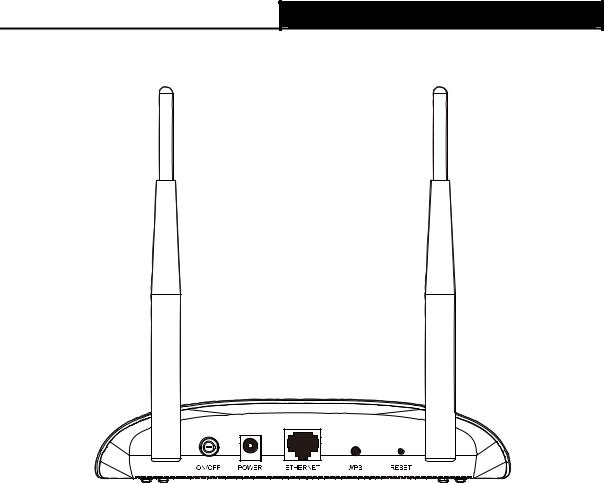
TL-WA801ND 300Mbps Wireless N Access Point User Guide
1.4.2 The Rear Panel
Figure 1-2
Viewed from left to right, the following parts are located on the rear panel of TL-WA801ND.
ON/OFF: The switch for the power.
POWER: The power port connects to the power adapter provided with the TL-WA801ND 300Mbps Wireless N Access Point.
Ethernet: One LAN 10/100Mbps RJ45 port connects to a network device, such as a switch or a router.
WPS: If you have client devices, such as wireless adapters, that support Wi-Fi Protected Setup, then you can press this button to quickly establish a connection between the device and client devices and automatically configure wireless security for your wireless network.
RESET: The Reset button is used to restore the AP’s factory default settings. There are two ways to reset the Access Point’s factory defaults:
zMethod one: With the AP powered on, use a pin to press and hold the Reset button (about 5 seconds) until the System LED becomes quick-flash from slow-flash. And then release the button and wait the AP to reboot to its factory default settings.
zMethod two: Restore the default settings from “System Tools > Factory Defaults” of the AP's Web-based management page.
Wireless antenna: The external antenna is used to transmit and receive wireless data.
) Note:
Ensure the AP is powered on before it restarts completely.
4

TL-WA801ND 300Mbps Wireless N Access Point User Guide
Chapter 2 Hardware Installation
2.1Before You Begin
Please read this User Guide carefully before installing and using the equipment. The operating distance range of your wireless connection can vary significantly depending on the physical position of the wireless devices. Factors that can weaken signals by getting in the way of your network’s radio waves are metal appliances or obstructions, and walls. Typical ranges vary base on the types of materials and background RF (radio frequency) noise in your home or office.
For best performance of your wireless network, you are suggested to:
1). Avoid redundant obstacles and interference between the wireless devices.
2). Keep your AP away from appliances with a strong electric field or magnetic field, such as a microwave oven or refrigerator.
Place the AP near the center of the area in which your computers operates.
2.2Basic Requirements
zUse only the power adapter provided with your AP
zThe electrical outlet shall be installed near the device and shall be easily accessible
zPlace your AP in a well ventilated place far from direct sunlight, any heater or heating vent
zLeave at least 2 inches (5cm) space around the device for heat dissipation
zTurn off your AP and unplug the power adapter in a lighting storm to avoid damage
zWeb browser, such as Microsoft Internet Explorer 5.0 or above, Netscape Navigator 6.0 or above
zOperating temperature: 0 ~40 (32 ~104 )
zOperating Humidity: 10%~90%RH, Non-condensing
2.3Connecting the Device
Figure 2-1 is an example of the typical application of TL-WA801ND in the infrastructure network. An Infrastructure network contains an access point or a wireless router.
5
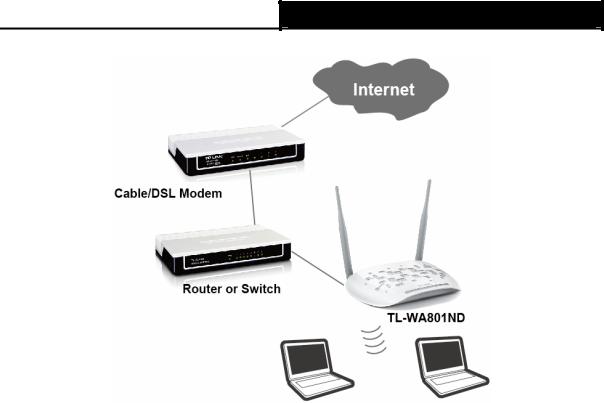
TL-WA801ND 300Mbps Wireless N Access Point User Guide
Figure 2-1 The Example of Infrastructure Network Incorporating the TL-WA801ND
To establish a typical connection of the AP, please take the following steps:
1.Connect the Cable or DSL modem to a Router.
2.Locate an optimum location for the AP. The best place is usually near the center of the area in which your PC(s) will wirelessly connect.
3.Adjust the direction of the antenna. Normally, upright is a good direction.
4.Connect the Ethernet Broadband Router to the TL-WA801ND Access Point. Power on the AP.
5.Then you can connect a desktop PC or laptop to your network. (Make sure your computer or laptop is equipped with a Wireless Adapter.)
) Note:
If you are not so clear about how to connect your devices to the network, please refer to Appendix A Application Example.
6
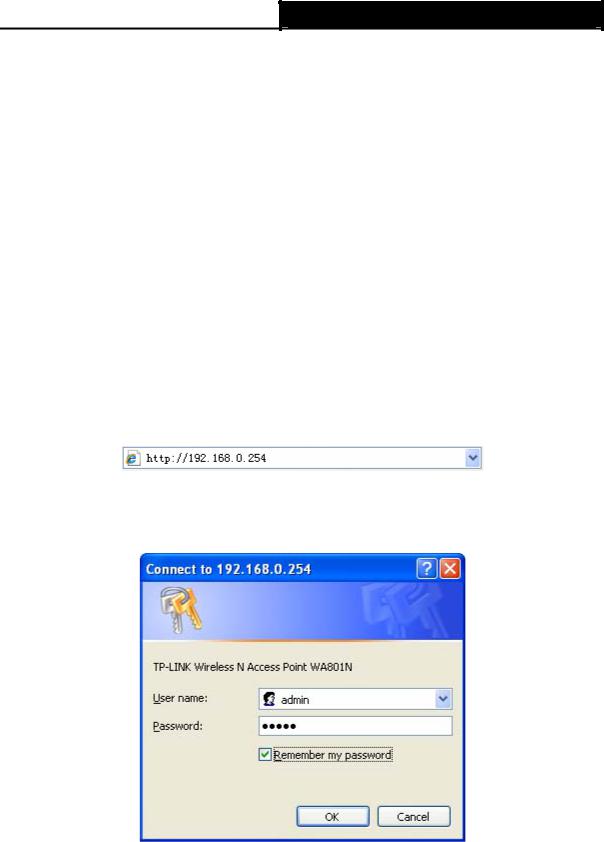
TL-WA801ND 300Mbps Wireless N Access Point User Guide
Chapter 3 Quick Installation Guide
This chapter will guide you to configure your PC to communicate with the AP and to configure and manage the TL-WA801ND 300Mbps Wireless N Access Point easily with a Web-based utility.
3.1Quick Setup
With a Web-based utility, it is easy to configure and manage the TL-WA801ND 300Mbps Wireless N Access Point. The Web-based utility can be used on any Windows, Macintosh or UNIX OS with a Web browser, such as Microsoft Internet Explorer, Mozilla Firefox or Apple Safari.
) Note:
If you cannot access the web-based configuration page, you can choose the two methods listed below based on your need:
¾To reconfigure the TL-WA801ND, please refer to T1 in Troubleshooting to reset the product.
¾To change only some certain settings of the TL-WA801ND, please refer to T3 in Troubleshooting to assign a static IP address 192.168.0.100 for your computer.
1.To access the configuration utility, open a web-browser and type in the default address http://192.168.0.254 in the address field of the browser.
Figure 3-1 Login to the AP
After a moment, a login window will appear, similar to the Figure 3-2. Enter admin for the User Name and Password (both in lower case letters). Then click OK or press Enter.
Figure 3-2 Login Windows
) Note:
If the above screen does not prompt, it means that your web-browser has been set to a proxy. Go to Tools menu>Internet Options>Connections>LAN Settings, in the screen that appears, cancel the Using Proxy checkbox, and click OK to finish it.
2.After successfully logging in, the Quick Setup page will display. Click Next to continue.
7
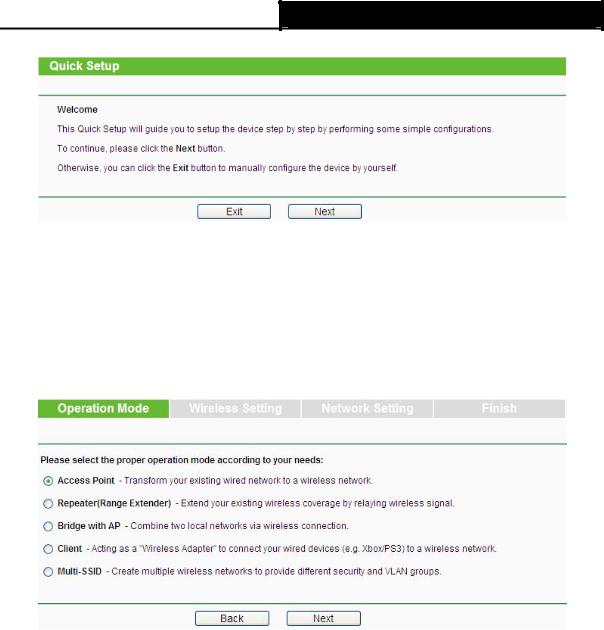
TL-WA801ND 300Mbps Wireless N Access Point User Guide
Figure 3-3 Quick Setup
) Note:
If you click Exit and choose to manually configure the AP on your own need, please note that the DHCP is enabled during the configuration, it is essential to disable DHCP when all the settings are finished.
3.The Operation Mode page will appear then, shown in Figure 3-4. The TL-WA801ND supports up to five operation modes.
Figure 3-4 Operation Mode
¾In Access Point mode, the product will act as a wireless central hub for your wireless LAN clients, giving a wireless extension for your current wired network.
¾In Repeater(Range Extender) mode, the product can extend the coverage of another wireless Access Point or Router. The universal repeater mode is for the wireless Access Point or Router which does not support WDS function.
¾In Bridge with AP mode, the product can wirelessly connect two or more remote LANs together.
¾In Client mode, the product will act as a wireless adapter to connect your wired devices (e.g. PC, Xbox, PS3, etc. ) to a wireless network.
¾In Multi-SSID mode, the product can be assigned up to four SSIDs to work with your VLAN.
4.Select the operation mode based on your need.
A.When you choose Access Point mode, the Wireless Setting page will be shown in Figure 3-5.
8
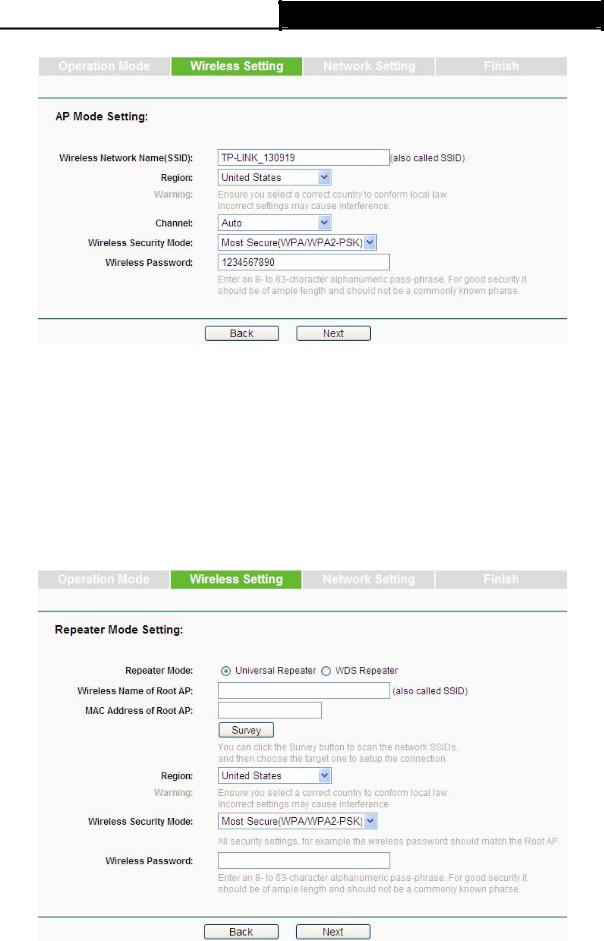
TL-WA801ND 300Mbps Wireless N Access Point User Guide
Figure 3-5 Wireless Setting - Access Point mode
1)Create an easy-to-remember name for your wireless network, write it into Wireless Network Name(SSID).
2)Select Region and Channel for your device.
3)Select Most Secure (WPA/WPA2-PSK) encryption mode and enter a password below to prevent unauthorized access to your AP.
4)Click Next, you will then come to Network Setting page for furthers configuration.
B.When you choose Repeater(Range Extender) mode, the Wireless Setting page will be shown in Figure 3-6.
Figure 3-6 Wireless Setting – Repeater(Range Extender) mode
9
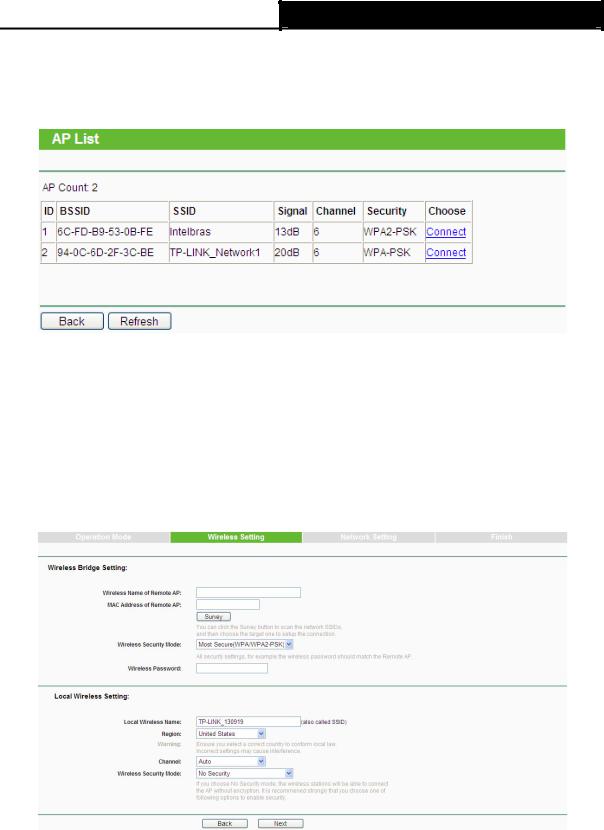
TL-WA801ND 300Mbps Wireless N Access Point User Guide
1)Select the Repeater Mode, for example Universal Repeater.
2)Click Survey, then the window displaying a list of available SSIDs will appear in Figure 3-7.
Figure 3-7 AP List
3)Find the SSID of the Access Point / Router or WISP, and click Connect in the corresponding row. You will then return to the previous page.
4)Select the security mode and enter the password that is the same as on your router or access point in Figure 3-6.
5)Click Next, you will then come to Network Setting page for furthers configuration.
C.When you choose Bridge with AP mode, the Wireless Setting page will be shown in Figure 3-8.
Figure 3-8 Wireless Setting – Bridge with AP mode
1)Click Survey, then the window displaying a list of available SSIDs will appear in Figure 3-7.
2)Find the SSID of the Access Point / Router or WISP, and click Connect in the corresponding row. You will then return to the page shown in Figure 3-8.
3)Select the security mode and enter the password that is the same as on your router or access point in Wireless Bridge Setting.
10
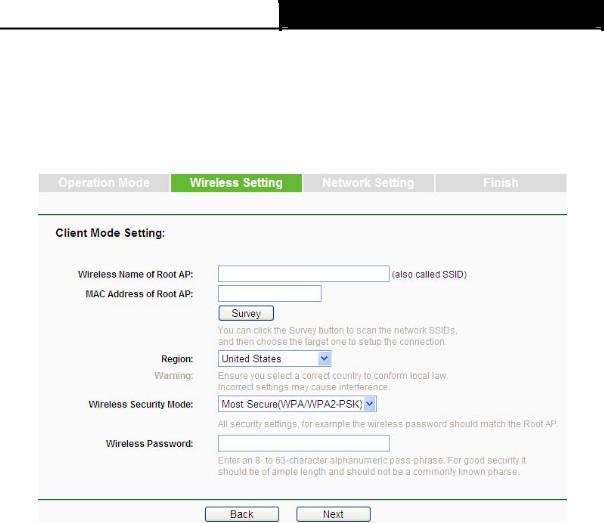
TL-WA801ND 300Mbps Wireless N Access Point User Guide
4)You can name the bridge AP in Local Wireless Name, and configure the Local Wireless Setting for the bridge AP.
5)Click Next in Figure 3-8, and you will come to Network Setting page for furthers configuration.
D.When you choose Client mode, the Wireless Setting page will be shown in Figure 3-9.
Figure 3-9 Wireless Setting – Client mode
1)Click Survey, then the window displaying a list of available SSIDs will appear in Figure 3-7.
2)Find the SSID of the Access Point / Router or WISP, and click Connect in the corresponding row. You will then return to the page shown in Figure 3-9.
3)Select the security mode and enter the password that is the same as on the root AP.
4)Click Next, you will then come to Network Setting page for furthers configuration.
E.When you choose Multi-SSID mode, the Wireless Setting page will be shown in Figure 3-10.
11
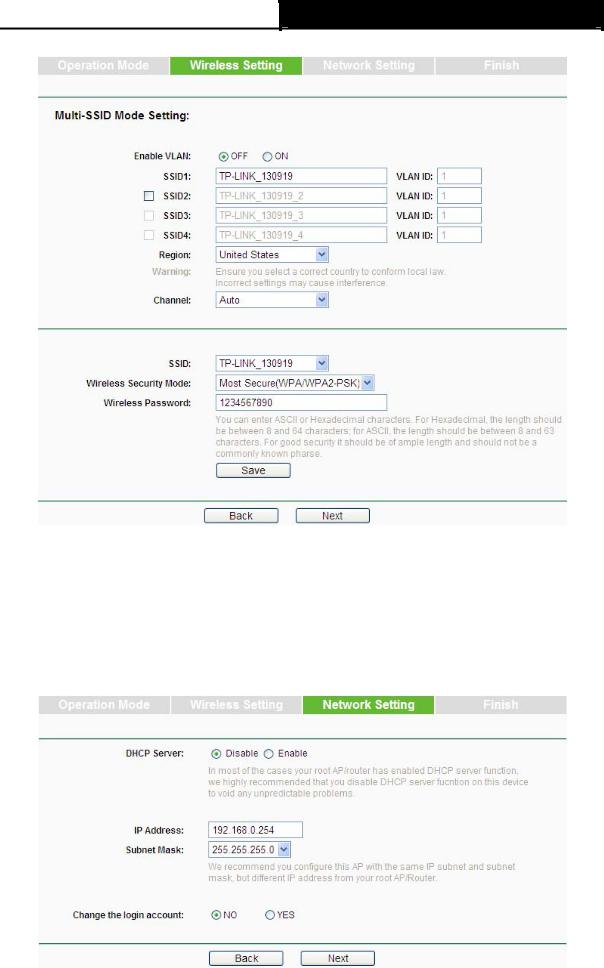
TL-WA801ND 300Mbps Wireless N Access Point User Guide
Figure 3-10 Wireless Setting – Multi-SSID mode
You are suggested to implement Multi-SSID function with a switch that supports Tag VLAN feature.
For advanced configuration of this step, please refer to explanations of this mode in 4.6.1 Wireless Settings.
5.When you have configured Wireless Settings in step 4, The Network Setting page will appear then, shown in Figure 3-11. It is recommended that you keep the default settings on this page.
Figure 3-11 Network Setting
12
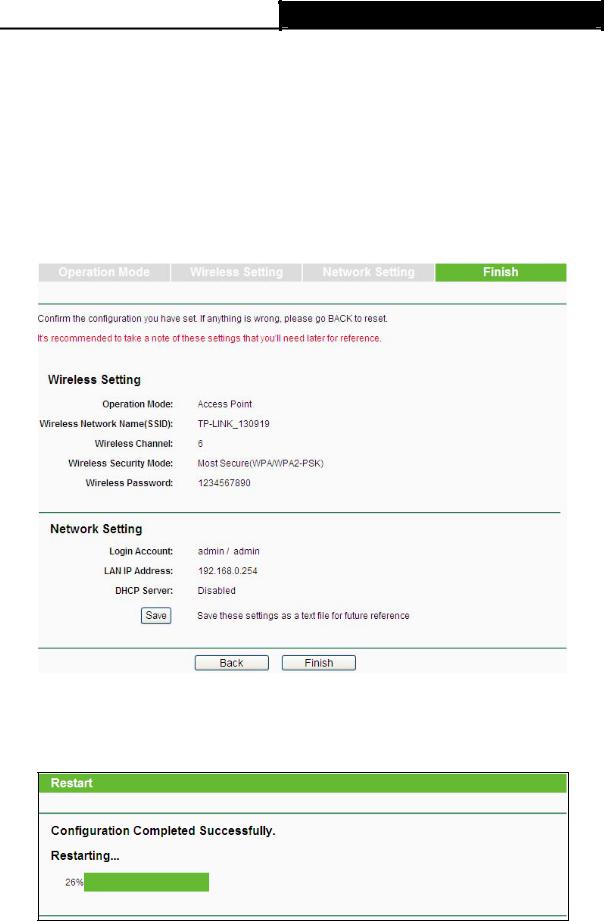
TL-WA801ND 300Mbps Wireless N Access Point User Guide
) Note:
1.These settings are only for basic wireless parameters, for advanced settings, please refer to 4.5 Network and 4.7 DHCP.
2.By selecting YES for Change the login account, you can modify your login user name and password. In this case, it is suggested that you record them in some place easy to find.
6.Click the Next button. You will then see the Finish page. Here takes the settings for Access Point mode for example.
Check your settings and click Save to save your settings for future reference.
Figure 3-12 Quick Setup – Finish
Click the Finish button. If something has changed during the configuration, the device will reboot to make the configuration take effect, as shown in Figure 3-13. Wait until the rebooting finish.
Figure 3-13 Quick Setup – Finish
13
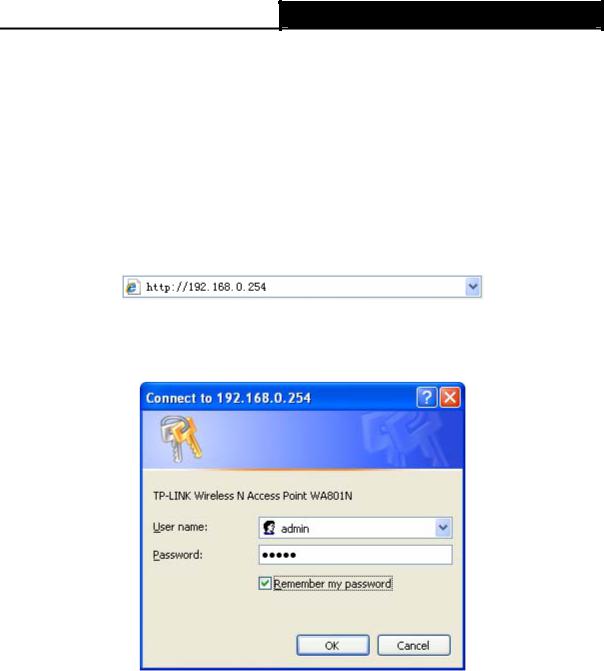
TL-WA801ND 300Mbps Wireless N Access Point User Guide
Chapter 4 Configure the Device
This Chapter describes how to configure your Access Point via the web-based management page. The TL-WA801ND 300Mbps Wireless N Access Point is easy to configure and manage with the Web-based (Internet Explorer, Netscape® Navigator, Firefox, Safari, Opera or Chrome) management page, which can be launched on any windows, Macintosh or UNIX OS with a web browser.
4.1Login
Open your web browser. Type in IP address http://192.168.0.254 in the address field of web browser and press Enter.
Figure 4-1 Login to the AP
Enter admin for the User Name and Password (both in lower case letters) in Figure 4-2 below. Then click OK or press Enter.
Figure 4-2 Login Windows
) Note:
If the above screen does not prompt, it means that your web-browser has been set to a proxy. Go to Tools menu>Internet Options>Connections>LAN Settings, in the screen that appears, cancel the Using Proxy checkbox, and click OK to finish it.
After a successful login, you can configure and manage the device. There are six main menus on the leftmost column of the web-based management page: Status, WPS, Network, Wireless, DHCP and System Tools. Submenus will be available after clicking one of the main menus. On the right of the web-based management page lies the detailed explanations and instructions for the corresponding page.
14
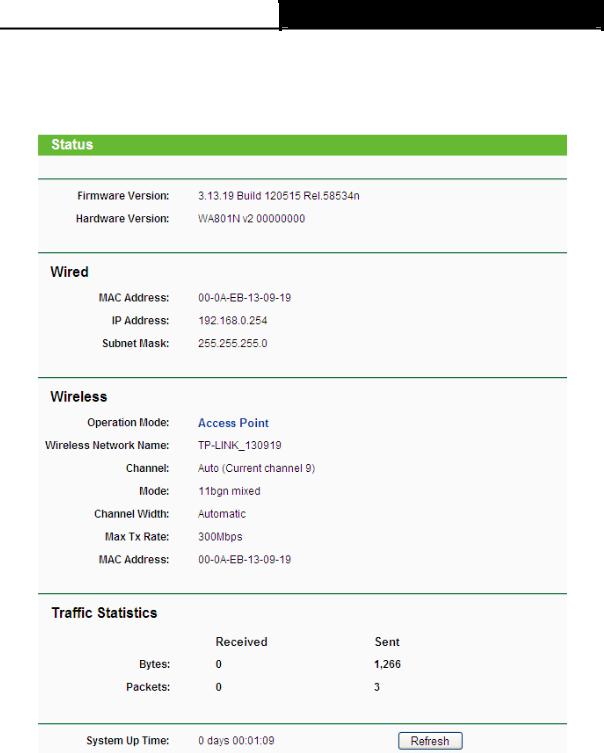
TL-WA801ND 300Mbps Wireless N Access Point User Guide
4.2Status
Selecting Status will enable you to view the AP’s current status and configuration, all of which is read-only.
Figure 4-3 Device Status
¾Firmware Version - This field displays the current firmware version of the AP.
¾Hardware Version - This field displays the current hardware version of the AP
¾Wired - This field displays the current settings or information for the Network, including the
MAC address, IP address and Subnet Mask.
¾Wireless - This field displays basic information or status for wireless function, including
Operating Mode, Wireless Network Name, Channel, Mode, Channel Width, Max Tx Rate and MAC Address.
¾Traffic Statistics - This field displays the AP's traffic statistics.
15
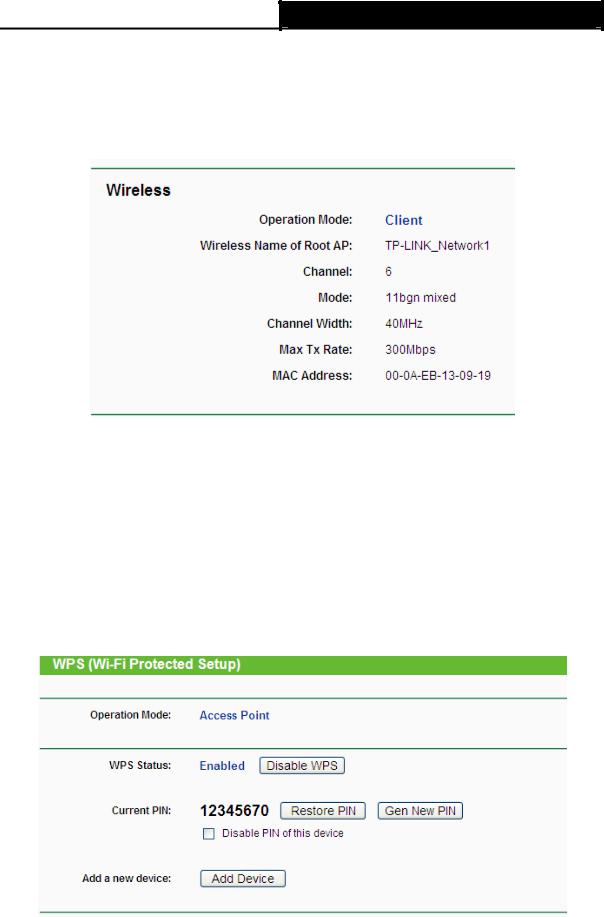
TL-WA801ND 300Mbps Wireless N Access Point User Guide
¾System Up Time - This filed displays the run time of the AP since it’s powered on or reset.
) Note:
If you select Client mode in Figure 4-12, the wireless status in Figure 4-3 will change, similar to the figure below:
Figure 4-4 Device Status - Client
4.3Quick Setup
Please refer to Section 3.1 Quick Setup for more details.
4.4WPS
WPS (Wi-Fi Protected Setup) can help you to quickly and securely connect to a network. This section will guide you to add a new wireless device to an existing network quickly by function. The WPS function is only available when the Operation Mode is set to Access Point and Multi-SSID. Here we take the Access Point mode for example. Select menu “WPS”, you will see the next screen shown in Figure 4-5.
Figure 4-5 WPS
¾WPS Status - To enable or disable the WPS function here.
16
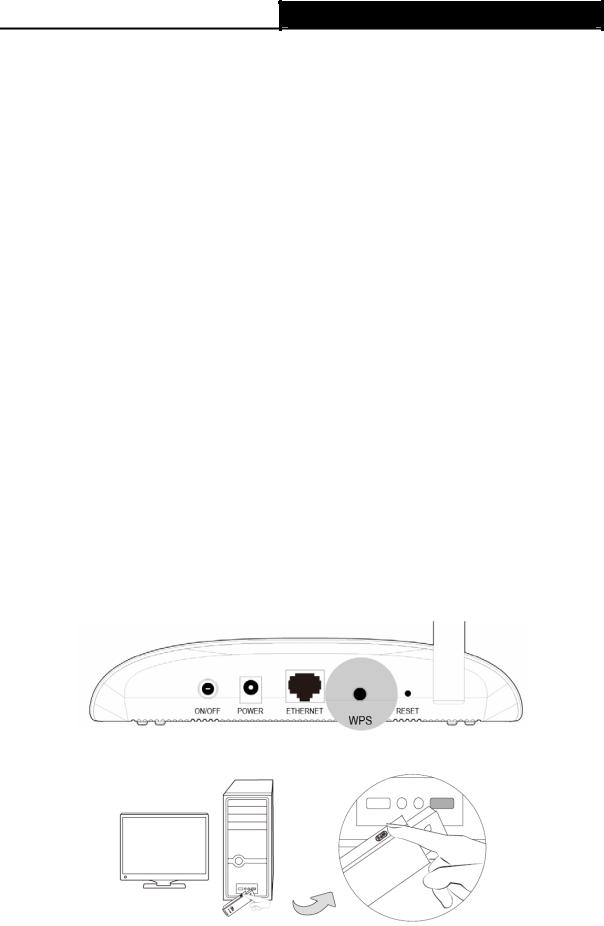
TL-WA801ND 300Mbps Wireless N Access Point User Guide
¾Current PIN - The current value of the device's PIN is displayed here. The default PIN of the device can be found in the label or User Guide.
¾Restore PIN - Restore the PIN of the device to its default.
¾Gen New PIN - Click this button, and then you can get a new random value for the device's PIN. You can ensure the network security by generating a new PIN.
¾Disable Router’s PIN - WPS external register of entering the device’s PIN can be disabled or enabled manually. If the device receives multiple failed attempts to authenticate an external Register, this function will be disabled automatically.
¾Add Device - You can add a new device to the existing network manually by clicking this button.
To add a new device:
If the wireless adapter supports Wi-Fi Protected Setup (WPS), you can establish a wireless connection between wireless adapter and device using either Push Button Configuration (PBC) method or PIN method.
) Note:
To build a successful connection by WPS, you should also do the corresponding configuration of the new device for WPS function meanwhile.
For the configuration of the new device, here takes the Wireless Adapter of our company for example.
I.By PBC
If the wireless adapter supports Wi-Fi Protected Setup and the Push Button Configuration (PBC) method, you can add it to the network by PBC with the following two methods.
Method One:
Step 1: Press the WPS button on the rear panel of the device.
Step 2: Press and hold the WPS button of the adapter directly for 2 or 3 seconds.
Step 3: Wait for a while until the next screen appears. Click OK to complete the WPS configuration.
17
